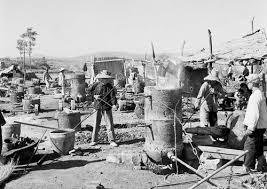
Quite a few posts here have focused on the question of emergence in social ontology, the idea that there are causal processes and powers at work at the level of social entities that do not correspond to similar properties at the individual level. Here I want to raise a related question, the notion that an important aspect of the workings of the social world derives from "system effects" of the organizations and institutions through which social life transpires. A system accident or effect is one that derives importantly from the organization and configuration of the system itself, rather than the specific properties of the units.
What are some examples of system effects? Consider these phenomena:
- Flash crashes in stock markets as a result of automated trading
- Under-reporting of land values in agrarian fiscal regimes
- Grade inflation in elite universities
- Increase in product defect frequency following a reduction in inspections
- Rising frequency of industrial errors at the end of work shifts
Safety approaches based on systems theory consider accidents as arising from the interactions among system components and usually do not specify single causal variables or factors. Whereas industrial (occupational) safety models and event chain models focus on unsafe acts or conditions, classic system safety models instead look at what went wrong with the system's operation or organization to allow the accident to take place. (KL 977)Charles Perrow offers a taxonomy of systems as a hierarchy of composition in Normal Accidents: Living with High-Risk Technologies:
Consider a nuclear plant as the system. A part will be the first level -- say a valve. This is the smallest component of the system that is likely to be identified in analyzing an accident. A functionally related collection of parts, as, for example, those that make up the steam generator, will be called a unit, the second level. An array of units, such as the steam generator and the water return system that includes the condensate polishers and associated motors, pumps, and piping, will make up a subsystem, in this case the secondary cooling system. This is the third level. A nuclear plan has around two dozen subsystems under this rough scheme. They all come together in the fourth level, the nuclear plant or system. Beyond this is the environment. (65)Large socioeconomic systems like capitalism and collectivized socialism have system effects -- chronic patterns of low productivity and corruption in the latter case, a tendency to inequality and immiseration in the former case. In each case the observed effect is the result of embedded features of property and labor in the two systems that result in specific kinds of outcomes. And an important dimension of social analysis is to uncover the ways in which ordinary actors pursuing ordinary goals within the context of the two systems, lead to quite different outcomes at the level of the "mode of production". And these effects do not depend on there being a distinctive kind of actor in each system; in fact, one could interchange the actors and still find the same macro-level outcomes.
Here is a preliminary effort at a definition for this concept in application to social organizations:
A system effect is an outcome that derives from the embedded characteristics of incentive and opportunity within a social arrangement that lead normal actors to engage in activity leading to the hypothesized aggregate effect.Once we see what the incentive and opportunity structures are, we can readily see why some fraction of actors modify their behavior in ways that lead to the outcome. In this respect the system is the salient causal factor rather than the specific properties of the actors -- change the system properties and you will change the social outcome.
When we refer to system effects we often have unintended consequences in mind -- unintended both by the individual actors and the architects of the organization or practice. But this is not essential; we can also think of examples of organizational arrangements that were deliberately chosen or designed to bring about the given outcome. In particular, a given system effect may be intended by the designer and unintended by the individual actors. But when the outcomes in question are clearly dysfunctional or "catastrophic", it is natural to assume that they are unintended. (This, however, is one of the specific areas of insight that comes out of the new institutionalism: the dysfunctional outcome may be favorable for some sets of actors even as they are unfavorable for the workings of the system as a whole.)
Another common assumption about system effects is that they are remarkably stable through changes of actors and efforts to reverse the given outcome. In this sense they are thought to be somewhat beyond the control of the individuals who make up the system. The only promising way of undoing the effect is to change the incentives and opportunities that bring it about. But to the extent that a given configuration has emerged along with supporting mechanisms protecting it from deformation, changing the configuration may be frustratingly difficult.
Safety and its converse are often described as system effects. By this is often meant two things. First, there is the important insight that traditional accident analysis favors "unit failure" at the expense of more systemic factors. And second, there is the idea that accidents and failures often result from "tightly linked" features of systems, both social and technical, in which variation in one component of a system can have unexpected consequences for the operation of other components of the system. Charles Perrow describes the topic of loose and tight coupling in social systems in Normal Accidents; 89 ff,)
